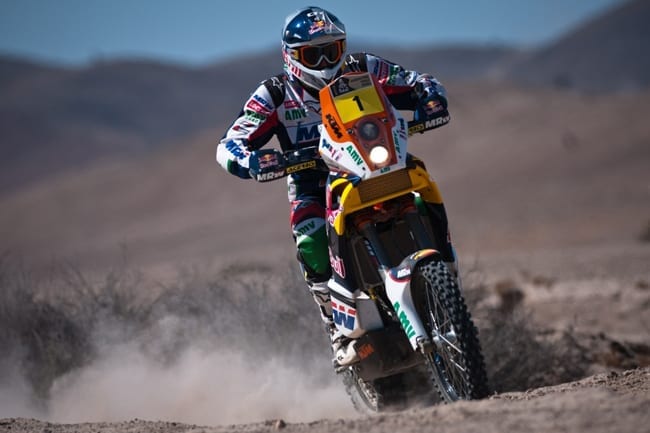When riders set out at Mar Del Plata on the Atlantic coast of Argentina on January 1 there were 178 in the start list of Dakar 2012. Now in Copiapo, Chile, for the one rest day of the 2012 rally after nearly 4,500 km the 33rd edition of the world toughest motor sports event it has again evolved into the tale of two riders – Cyril Despres and Marc Coma of the KTM factory team.
French rider Despres is in the overall lead with a cushion of almost eight minutes on team-mate Marc Coma of Spain. But that is only half of the story. Third placed Helder Rodrigues of Portugal is almost 50 minutes behind Despres and that will be very difficult to overcome.
KTM’s riders have one every edition since 2001, except in 2008 when the rally was cancelled on the eve of departure from Lisbon following security threats in North Africa.
Looking ahead, riders have another 3,795 km including around 1,500 of timed special stages before they reach the finish in Lima. While they still have much hard territory in Chile to negotiate, they will break new ground on January 11 when they enter the coastal desert of Peru, the third country to be integrated into the South American Dakar.
It is clear that the focus will be on Despres and Coma in the coming days and the race to the finish line has a lot at stake for both riders. Despres, with two stage wins to his credit so far will be doing what he can to retain his lead. Coma, who has won three stages, will be doing whatever is needed to erode that same lead. As stage seven indicated, the two riders are so equally matched that they can finish a 420km timed special no less than two minutes apart. On the other hand, both riders have had the bitter experience in past African Dakar Rallies of seemingly having victory in their hands in the finals stages, only to see it disappear and go to their rival. The Dakar 2012 is still very much open.
Cyril Despres: “Now we are at the bivouac where we will stay for tomorrow’s rest day. The idea is to take it easy and recharge your batteries ready for the second week of racing. It will also be a chance for me to go through my bags, sort out my stuff, talk to my team… If everything goes according to plan I might even squeeze in a siesta.”
Marc Coma: “We arrive at the halfway point with options, nearly eight minutes behind Cyril, a difference that is not impossible to recover. It’s true that it will be difficult but considering how many kilometres are left, seeing the race left, I am an optimist and today’s stage (stage seven) helped me a lot psychologically.”
With the Dakar Rally now at its halfway point, Laia Sanz weighs up her performance so far in this 2012 event. Last year’s Dakar women’s champion is the only woman still in the race and holds 51st place in the provisional classification for motorbikes.
Q: In the fourth stage you had a fall and injured your right hand. How is it now?
A: “My hand is now fine. On the day of the fall I was really scared because the hand was very swollen and I couldn’t hold the handlebar. I thought I had broken it but fortunately not and in three days with the help of the physiotherapist [Miguel Ángel Domínguez] it is already much better.”
Q: After the first week how are you feeling?
A: “Now I’m fine. The truth is that I found the first three days very tough and more exhausting than these last. Perhaps it is because now I’m into the rhythm of not sleeping very much. Anyway, I think I have got through to the rest day in good shape, even yesterday in the last part of the stage I felt well which means that I’m in good shape. I feel strong.”
Q: Did you expect the first week to be so hard?
A: “The initial impression was that the Dakar would be very hard because I found the first stages very difficult. Perhaps there were fewer kilometres than last year but they were very slow to do and very physical and then it was also very hot and it was easy to become dehydrated.”
Q: Last year you came to the rest day in 48th place. How do you rate your results this time?
A: “I had hoped to be a little higher up. If it hadn’t been for the hole in the fuel tank which happened when I fell and which lost me a lot of time I would be much better classified, particularly because when you have a problem which drops you down the classification the next day it is much harder to get into the rhythm. What happens is that the people in front of you are going more slowly than you are but you are held back by the dust that they throw up and you cannot get past and it ends up as a vicious circle.”
Q: What can we expect from you for the rest of the race?
A: “If I stay steadily among the first 50 I can improve on the 39th place of last year. What is important is to understand that I don’t need to ride very fast but I do need to go without hurry, without taking risks and being aware that people will be dropping out. The Dakar above all is a race against oneself. We have now changed the engine to be safer and more confident on the mechanical side. A lot of people have preferred to wait but I fear that some will soon have problems because the desert is very damaging.”
Q: How is the Gas Gas 450 going?
A: “The bike is going very well, with no problems. This project was prepared in a very short time and without doing any training in Morocco so that naturally every day we see some detail to be improved but I am very satisfied.”
Q: Last year you had Jordi Arcarons as a back-up rider. How are things with your new companion Marc Guasch?
A: “I am pleasantly surprised as I did not think we would get on together so well. We are doing a great job and I even believe I have done more kilometres with him than I did last year with Jordi. Marc wants us to go quietly, he advises me very well and keeps me calm.”
Q: You are the only woman left in the race. What has happened this year?
A: “In this Dakar, Rosa Romero and I were the only two in the motorbike class. I was rather surprised but it’s possible that the toughness of the Dakar has discouraged more than one. I imagine that the economic situation at the moment is no help either. I would like to have competed against more girls.”









